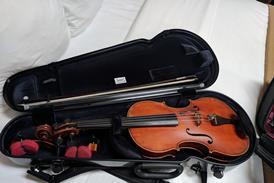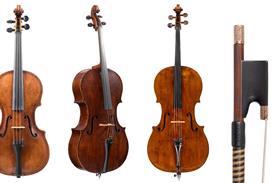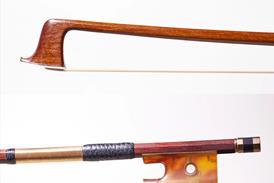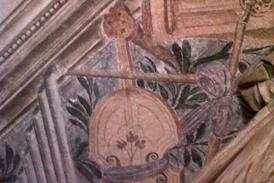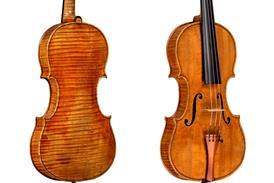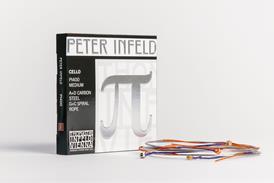All Masterclass articles – Page 3
-
 Premium ❘ Feature
Premium ❘ FeatureMasterclass: Debussy Violin Sonata in G minor
Fedor Rudin explores the emotionally volatile first movement of a sonata written by an anxious composer tormented by illness, old age and war
-
 Premium ❘ Feature
Premium ❘ FeatureMasterclass: Simon Standage on Bach’s Violin Sonata in E major
Early music expert Simon Standage discusses historically informed performance, interpretation and balancing violin and harpsichord in the first two movements of BWV1016
-
 Premium ❘ Feature
Premium ❘ FeatureMasterclass: Bruch’s Kol Nidrei op.47
Amanda Forsyth talks about finding inspiration from a Jewish cantor to help her play emotional slides and singing phrases
-
 Premium ❘ Feature
Premium ❘ FeatureMasterclass: Eldbjørg Hemsing on Grieg Violin Sonata no.2 in G Major
To bring out all the joy, innocence and darkness in this first movement, it is essential to understand its combined roots in classical composition and Norwegian folk music, explains Eldbjørg Hemsing
-
 Premium ❘ Feature
Premium ❘ FeatureMasterclass: violist Emilie Hörnlund on Beethoven String Quartet op.59 no.1
Swedish violist Emilie Hörnlund, of the Chiaroscuro Quartet, discusses how to achieve optimal articulation, balance and flow in the first movement of the first ‘Rasumovsky’ Quartet
-
 Premium ❘ Feature
Premium ❘ FeatureMasterclass: Beethoven String Quartet op.132
Jacqueline Thomas, cellist of the Brodsky Quartet, which celebrates its 50th anniversary this year, looks at a third movement written by a composer convalescing from a near life-ending illness
-
 Premium ❘ Feature
Premium ❘ FeatureMasterclass: Moray Welsh on Schubert’s Arpeggione Sonata first movement
Moray Welsh looks at the cello version of the first movement, whose successful execution requires boundless musicality, lyricism and technical finesse
-
 Premium ❘ Feature
Premium ❘ FeatureMasterclass: Bruch Romance for Viola and Orchestra op.85
Violist and composer Konstantin Boyarsky considers nerves, narrative and the influence of the opera in his discussion of this late Romantic piece
-
 Premium ❘ Feature
Premium ❘ FeatureMasterclass: A lesson in performing short pieces by Wolfgang Emanuel Schmidt
The cellist gives advice on how to present Fauré’s Élégie, Elgar’s Salut d’amour, and Saint-Saëns’s ‘The Swan’ with colour, contrast and expression
-
 Premium ❘ Feature
Premium ❘ FeatureMasterclass: Richard O’Neill on Brahms’ String Quartet no.3 op.67
The Takács Quartet violist looks at the first and third movements of this well-loved B flat major work, where his instrument is thrown into a rare spotlight
-
 Premium ❘ Feature
Premium ❘ FeatureMasterclass: Natalie Clein on Haydn Cello Concerto in D major
The cellist discusses the improvisational freedom, humour and joy that are central to her own interpretation of the first movement of this popular audition piece
-
 Premium ❘ Feature
Premium ❘ FeatureMasterclass: Antoine Tamestit on Brahms Viola Sonata op.120 no.1 third and fourth movements
Folk dance and fireworks all feature in Antoine Tamestit’s discussion of the third and fourth movements, in the second of two articles about the complete F minor Sonata
-
 Premium ❘ Feature
Premium ❘ FeatureMasterclass: Antoine Tamestit on Brahms Viola Sonata op.120 no.1 first and second movements
Antoine Tamestit discusses how he found an ideal piano–viola balance and came to love Brahms, after a long struggle. Here he covers the first and second movements, in the first of two articles
-
 Premium ❘ Feature
Premium ❘ FeatureMasterclass: Tchaikovsky Souvenir d’un lieu cher
Violinist Jennifer Koh explores how imagination and a flexible technique can help to bring out varied colours and a feeling of dance in these three short works
-
 Premium ❘ Feature
Premium ❘ FeatureMasterclass: Alisa Weilerstein on Chopin’s Cello Sonata in G minor op.65
The American cellist explores how to bring out all the romantic charm of the first movement using fingerings and bowings, without over-reliance on vibrato, rubato or a sticky, sickly sound
-
 Premium ❘ Feature
Premium ❘ FeatureMasterclass: Simon Standage on Bach’s Violin Sonata in E major part 2
British violinist Simon Standage looks at the Adagio ma non tanto and ‘firework’ finale, in the second of two articles exploring this 18th-century work for violin and harpsichord
-
 Premium ❘ Feature
Premium ❘ FeatureMasterclass: Alban Gerhardt on Saint-Saëns Cello Concerto no.1, part 2
Alban Gerhardt explains why it takes courage to fight tradition and forge your own interpretation – based not on what others play but on what the composer wrote – in the work’s third movement
-
 Premium ❘ Feature
Premium ❘ FeatureMasterclass: Alban Gerhardt on Saint-Saëns Cello Concerto no.1
In the first of two articles, the German cellist shows the importance of pulse, planning and precision in the first two movements of this underestimated Romantic concerto
-
 Premium ❘ Feature
Premium ❘ FeatureMasterclass: Hagai Shaham on Brahms Violin Sonata no.3
In his explorations of the first movement, the Israeli violinst discusses the German composer’s clear performance instructions, intimate Romantic style and self-critical nature
-
 Premium ❘ Feature
Premium ❘ FeatureMasterclass: Haydn C major Cello Concerto
Red Priest’s Angela East discusses her approach to phrasing and sound in the first movement, and the influence of Baroque and early-Classical vibrato, bowing and style
- Previous Page
- Page1
- Page2
- Page3
- Page4
- Next Page


